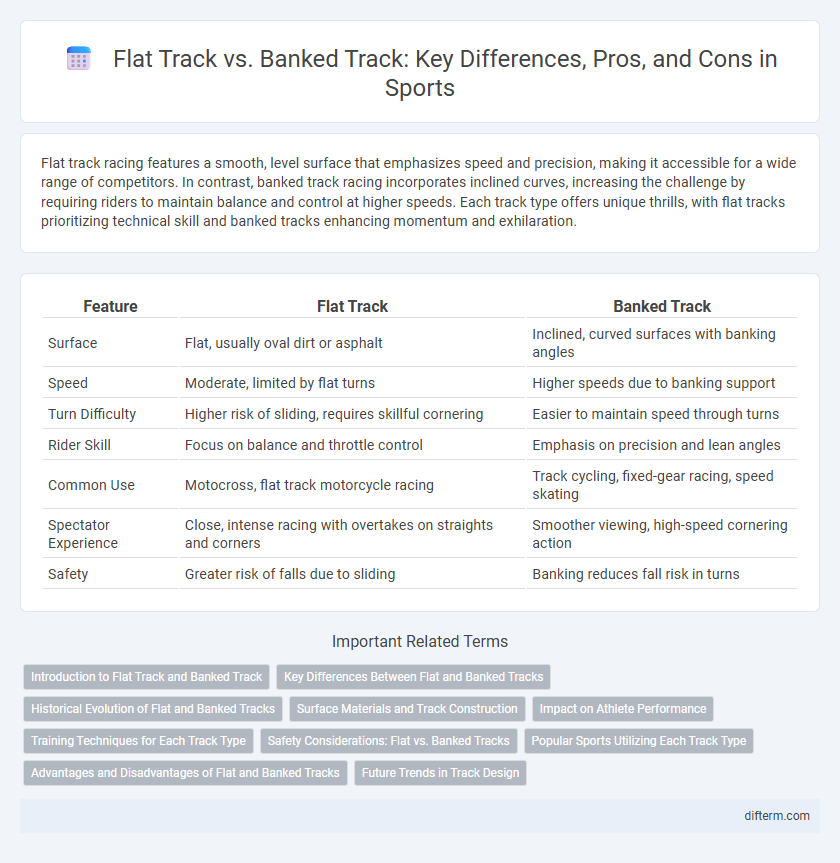Flat track racing features a smooth, level surface that emphasizes speed and precision, making it accessible for a wide range of competitors. In contrast, banked track racing incorporates inclined curves, increasing the challenge by requiring riders to maintain balance and control at higher speeds. Each track type offers unique thrills, with flat tracks prioritizing technical skill and banked tracks enhancing momentum and exhilaration.
Table of Comparison
| Feature | Flat Track | Banked Track |
|---|---|---|
| Surface | Flat, usually oval dirt or asphalt | Inclined, curved surfaces with banking angles |
| Speed | Moderate, limited by flat turns | Higher speeds due to banking support |
| Turn Difficulty | Higher risk of sliding, requires skillful cornering | Easier to maintain speed through turns |
| Rider Skill | Focus on balance and throttle control | Emphasis on precision and lean angles |
| Common Use | Motocross, flat track motorcycle racing | Track cycling, fixed-gear racing, speed skating |
| Spectator Experience | Close, intense racing with overtakes on straights and corners | Smoother viewing, high-speed cornering action |
| Safety | Greater risk of falls due to sliding | Banking reduces fall risk in turns |
Introduction to Flat Track and Banked Track
Flat Track racing takes place on oval dirt tracks with flat, smooth surfaces, allowing riders to slide their motorcycles through turns at high speeds. Banked Track racing features tracks with tilted curves, where the inclined surfaces help maintain traction and enable faster cornering. Both formats emphasize different skill sets and bike setups, contributing to varied race strategies and excitement in motorcycle racing.
Key Differences Between Flat and Banked Tracks
Flat tracks feature a level surface that demands precise cornering skills and consistent speed control, emphasizing rider balance and throttle management. Banked tracks incorporate angled curves that aid in maintaining higher speeds through turns by leveraging centrifugal force and improved traction. These structural differences significantly impact race strategies, bike setup, and rider technique, with banked tracks often favoring aggressive, high-speed cornering.
Historical Evolution of Flat and Banked Tracks
Flat track racing originated in the early 1900s as a simpler form of motorcycle competition on oval dirt tracks, emphasizing speed and rider control without the use of inclined surfaces. Banked tracks emerged later to increase cornering speeds and spectator excitement, featuring angled turns that allowed higher velocity and reduced skidding. The evolution from flat to banked tracks revolutionized motorcycle racing dynamics, influencing modern track design and rider techniques.
Surface Materials and Track Construction
Flat track racing typically uses packed dirt or clay surfaces that provide consistent grip and allow for controlled sliding, while banked track racing features wooden or concrete surfaces with angled curves designed to enhance speed and centrifugal force management. Banked track construction involves elevated curves built with precise inclines to facilitate higher cornering speeds, whereas flat track construction emphasizes wide, flat turns to prioritize maneuverability and traction. Surface materials and construction techniques in each track type directly influence tire wear, rider stability, and overall race dynamics.
Impact on Athlete Performance
Flat track racing demands greater technical skill and balance due to minimal incline, challenging riders to maintain consistent speed and control on a level surface. Banked track racing allows athletes to achieve higher speeds and improved cornering by leveraging the inclined curves, reducing the need for intricate maneuvering. The physical effort in flat track events emphasizes endurance and precise throttle control, whereas banked track competitions prioritize explosive power and dynamic body positioning.
Training Techniques for Each Track Type
Flat track training emphasizes endurance and precise bike control on smooth, level surfaces, with drills focusing on maintaining consistent speed and executing controlled slides. Banked track training prioritizes mastering high-speed cornering and leveraging centrifugal force, incorporating exercises that improve balance and body positioning on inclined curves. Tailoring training to each track's unique demands enhances rider performance and race strategy effectiveness.
Safety Considerations: Flat vs. Banked Tracks
Flat tracks typically present higher risks of collisions and falls due to the lack of inclines that help riders maintain speed and control. Banked tracks reduce the likelihood of riders sliding out by allowing centrifugal forces to keep motorcycles stable during turns, enhancing overall safety. Protective gear remains essential on both track types, but the design of banked tracks generally results in fewer serious accidents.
Popular Sports Utilizing Each Track Type
Flat track racing is predominantly used in sports like flat track motorcycle racing and roller derby, where smooth, level surfaces enable high-speed maneuvering and tactical positioning. Banked track racing is favored in disciplines such as speed skating and indoor cycling, where the angled curves facilitate greater centrifugal force management and faster cornering speeds. These track differences critically influence the dynamics, strategies, and athlete performance in their respective sports.
Advantages and Disadvantages of Flat and Banked Tracks
Flat tracks offer easier construction and maintenance, providing consistent racing conditions that favor technical riding skills, but they can result in slower speeds and less dynamic racing compared to banked tracks. Banked tracks enhance speed and cornering, creating more exciting and competitive races due to their inclined curves, yet they require higher maintenance costs and pose greater safety risks for riders. Choosing between flat and banked tracks depends on balancing budget constraints, rider experience, and the desired racing intensity.
Future Trends in Track Design
Future trends in track design emphasize enhanced safety features and adaptive surfaces for both Flat Track and Banked Track racing to improve rider performance and reduce injuries. Innovations include smart materials with real-time monitoring capabilities and modular track components allowing rapid configuration changes for diverse racing formats. Integration of augmented reality and data analytics is expected to optimize training and spectator engagement, driving a more immersive and technologically advanced edge in motorcycle racing.
Flat Track vs Banked Track Infographic

 difterm.com
difterm.com